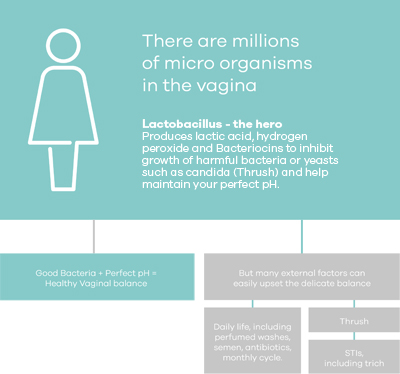Is Bacterial Vaginosis (BV) an STI?
Sex can definitely trigger BV – so that means it’s an STI right? Wrong. BV can be triggered by sex without a condom, or oral sex, because semen or saliva can upset your natural balance and allow some bacteria to flourish. It can’t be caught or passed on by your partner.
BV is caused by bacteria that are already present in your vagina but are normally being kept in check by your body’s own defences. STI’s on the other hand are infections that can be passed from person to person via sexual contact. Just to add to the confusion, having BV CAN sometimes increase your risk of contracting an STI. Confused? Most of us are! The problem is that so many of us don’t really know what goes on inside our vaginas, and so our chances of keeping them healthy and avoiding vaginal conditions such as BV are slim. Here’s the lowdown on what goes on inside your vagina – once we understand this and what triggers our BV we can help ourselves to avoid this condition.
BV occurs when there is a change in the normal pH of your vagina, which can affect the balance of micro-organisms that are keeping things in good health:

In a healthy vagina, the environment is slightly acidic, thanks to the presence of good bacteria (lactobacilli) that produce lactic acid and hydrogen peroxide. These things keep harmful bacteria in check and keep the normal vaginal pH level, which is slightly acidic. If lactobacilli are in short supply, the vagina becomes less acidic and other more harmful bacteria can grow, causing BV. Sex without a condom with a male partner can involve semen which is naturally alkaline, ending up in the vagina and upsetting this natural balance. Oral sex has a similar effect due to the bacteria present in the saliva, which can upset your natural vaginal balance.
Check your symptoms
BV is short for Bacterial Vaginosis. Symptoms of bacterial vaginosis can vary from person to person, but if you notice either a fishy smell, or if your discharge is grey or watery. If you’re not sure what the problem is try the Balance Activ Symptom Checker – developed with the Intimate Health Taskforce (a team of healthcare professionals and women with BV who are passionate about helping women identify and treat their BV). It’s important that you know if you have BV as it can often be confused with thrush or common STIs such as trichomoniasis (trich or TV for short), all of which need different treatments. You should go to your doctor or local sexual health clinic to be screened if you’re worried about having an STI. Don’t be embarrassed – they’ve seen it all before, and avoiding treatment can make matters worse.
Don’t worry, BV is very common, in fact more women in the UK suffer from BV than any other vaginal health condition, and it is twice as prevalent as thrush. BV is often mistaken for thrush, which is in fact less common but is better-known. SO, even though it can be triggered by sex, having BV doesn’t mean your partner is suddenly cheating on you, or has passed something on. BV needn’t be a problem as it is easy to treat once you know what you’re dealing with. You can try using a lactic acid gel such as Balance Activ to quickly and effectively get rid of the symptoms. If you notice that you get BV after having sex, you can also try using Balance Activ after sex to help prevent it from coming back because it helps to boost the growth of good bacteria, lactobacilli, and restores your normal vaginal pH. Your doctor can also prescribe antibiotics to treat your BV.